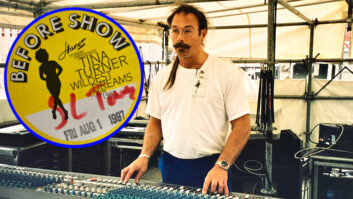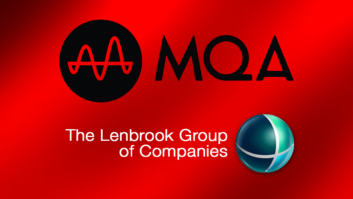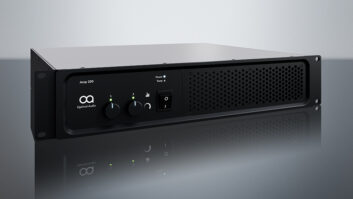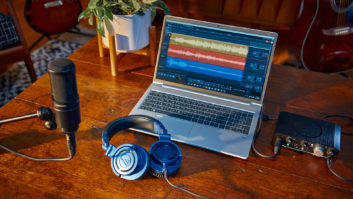The west coast of Ireland: It’s the stuff of poetry. Many people would trade most of what they have to live out there on the spectacular green, wind-whipped edge of the world. But how many people could make a living out there? Not too many, but count Davy Spillane among the talented few. Spillane is an in-demand musician who has played Uilleann pipes and/or low whistles on recordings by Van Morrison, Elvis Costello, Kate Bush, Bryan Adams, Sinead O’Connor and others. He also contributed to the scores for films such as Rob Roy and Michael Collins and helped develop the music for the ridiculously popular Riverdance show. And for the past several years, he has operated a studio, Burrenstone, in his home out in beautiful County Clare.
Spillane has been an important part of Ireland’s music scene since he was a founding member of the band Moving Hearts in the early ’80s. (That group also included Donal Lunny, Christy Moore, Eoghan O’Neill, Brian Calnan and Keith MacDonald.) Later he began releasing solo albums, starting with Out of the Air in 1988. By the time he had written material for A Place Among the Stones (Sony, 1996), his home studio was up and running-at that time equipped with a Spirit by Soundcraft console, which he later replaced with an Amek Einstein-and he recorded and mixed the album there. Over the past few years, his studio setup has evolved, and his latest effort, The Sea of Dreams, was also recorded and mixed almost entirely at home, with some remixing done later at Notes On studio in New York City.
The Sea of Dreams is a ravishing collection in that way that Irish pipes and whistles can be: sometimes sweet, sometimes anthemic, and don’t spare the reverb. Spillane’s writing and playing are extremely emotional. All of the songs are instrumentals (including a version of “My Heart Will Go On”), except for two that Sinead O’Connor sings: an original called “The Dreaming of the Bones” (lyrics by O’Connor) and a surprisingly fresh version of “Danny Boy.” Mix spoke with Spillane about the recording of this homemade CD when he was in New York just after the album was released.
Tell me about how the material for this record evolved.
I live in the west of Ireland, about 15 minutes’ walk from the cliffs. It’s a very beautiful place, and that has a big effect on me. Landscape is important; it contributes a lot of what music you’re doing, I believe. I have a studio in the house, so it evolves here from day one. I write all the melodies, and we kick things around.
The Sea of Dreams is a sensitive record in terms of the emotions that are on it; it’s very open. Of all the music I’ve done, it seems to me that the slower music was the stronger music, so that was a choice I made on reflection. It just seemed stronger and more valid, more affecting. So I developed this music over the last couple of years since the last record, A Place Among the Stones.
When I write music, I procrastinate a lot, and these melodies come out of the pain of procrastination. I procrastinate about stuff forever and a day, and then I’ll craft it pretty quickly.
How long did you spend writing material for this record?
Not a hell of a long time writing it; I wouldn’t say more than ten days end to end, but it took a long time to arrange and record and produce and deliver, mainly because of interruptions like Riverdance and various other work I was doing.
When did you start?
About three-and-a-half years ago.
Tell me about some of the people who worked with you on this record.
I had an electric band going for many years that included the musicians that are on the record. Greg Boland is the guitarist and co-producer with me; James Delaney, keyboard player; Tony Molloy, bass player; and Paul Moran on percussion. Myself and Greg would work away arranging it, the stuff I put together, and we wrote some together. Well, actually, the writing credits for co-writing usually had to do with arrangements. I write the melodies, co-arrange it and then go about the recording process. We usually do that together, myself and Greg with a sequencer, and then when we have it shaped up the way we want it, we’d get our musicians in to place all the sequences.
And then there’s Colin Boland, who was the engineer on this album-on my last two albums. He’s the brother of Greg, and they’re both the brothers of Andrew Boland, who runs Windmill One on Ringsend Road in Dublin.
What’s the studio like?
I’ve got a house overlooking the Skella Bay down to Kerry. It’s the same level as the cliffs. It’s got a huge vista, a 60-mile horizon. The house is an L-shaped, domestic house, but I’ve also got my pipe-making workshop, where I make musical instruments, and the studio. It’s all on a slant, where the control room is higher than the music room, and it’s all going with the slant of the mountain down to the sea.
How did you begin making your own pipes?
Well, in the very early days of playing, when I was still only about 16, that came about out of trying to keep my pipes working. Then I got access to a workshop and it grew into a full-fledged apprenticeship for a master pipe-maker. His name is Johnny Burke, a famous pipe-maker, and that was always running in parallel to my musical events. I’d do it really intensely for a while, and then I’d be back on the road again, and then I’d do another very solid week. It’s kind of like studying in your spare time.
Do you build pipes for other people?
Oh, yeah. I have orders from America and lots of different places. I sent a set of pipes to Moscow awhile ago, and there’s an aircraft controller in America that wants a set of pipes, as well.
Is it surprising to get orders from so far afield? It’s an unusual instrument for people to play.
It is unusual, but it’s nice. It’s only a sideline for me at the moment, but I make them to a professional standard, and I enjoy it.
Back to your studio: Did you design it yourself?
Yes. I have a fair bit of knowledge of that. I’ve kept it and upgraded it as I’ve gone along myself, and I wired it myself.
How long have you had a working studio?
Five years now, maybe longer. I made all the last album in it. This one here was remixed in New York, but it doesn’t make any difference. The mixing quality was actually probably as good if not better on the last album.
What type of equipment do you have now?
I had a Spirit desk when I first started, but then I got a Super E Amek Einstein, and it’s quite a comprehensive desk. Now I’m moving into [Yamaha] 02Rs, with really good mic preamps. I’m getting the [Amek] 9098RN, and I’m using them straight to tape. I’ve gotten rid of my ADATs. I’ve got very good mics-I’ve got the Sony C800G valve mic, I’ve got a stereo AKG C-24-and nice mic preamps, and I’ll be going straight into the hard disk with them. And I’m using [MOTU] Digital Performer as my multitrack; I haven’t recorded anything on that yet, but I’ll be heading into that now.
How did you decide to make the change to recording to hard disk?
It’s because of the preamps. You’re going through, like, the preamp slices of an extremely expensive desk. It takes care of any reservations about the desk’s converters. You’re going straight to your hard disk with really very good mic preamps, which is like using an amazing, expensive desk and just monitoring all back through the 02Rs, which they’re really properly best at. I have no reservations about recording with them through their preamps either, but I’ll record maybe B and C instruments through them-DI stuff like guitars, basses and maybe secondary mics. And I’ve also got some high-end outboard: Eventide 4000s, Lexicons.
What are the monitors?
The speakers are Meyer HD-1s and ATC 100As. The HD-1s and the subbass were made for Mike Oldfield, actually. He just got a second system, so he gave me them. That’s a really nice system, and I have the ATC 100s because I like them as well, even though they’re not too dissimilar [from the HD-1s] in some respects. The ATCs are very subtle; they’re beautiful speakers.
Is this the setup you used on Sea of Dreams?
No. The 02Rs and the Mark of the Unicorn are for the next recording onward. This record was recorded and mixed with my previous setup, which was the ADATs and the Einstein desk.
How did you lay down the tracks for Sea of Dreams? What do you record first?
The first thing we do is discuss the album, and we’d mark out, very roughly, how different the tempos of the tracks were going to be from each other, and what the whole mood was that we were trying to achieve with the record, plus the time signatures the pieces were going to be in. We’d try to map out, song by song, a click track in the very basic time signature, with a little feel in it maybe. We use that as a skeleton. Then we busk away at designing what the guitar accompaniment should be, or the percussion. We’d have all that mocked up without recording it anywhere, not even on the sequencer.
Then we’d start compiling. Percussion performances would be from a Roland R-8 drum module with the sequencer. Then we’d start putting down maybe acoustic guitar and some guide top lines. Then we’d layer it and build a bit more. Then when we had it where we want it, across the whole album, we’d get the musicians down to the place. Before the musicians come in, the album would be just low whistle and pipes, maybe acoustic guitar and some small electric guitar, the R-8, and my Kurzweil S1100, and that’s it; there’d be only like two real things on it.
We did this in three- or four-day bouts. We wouldn’t work together for more than four days at a time. Then we’d wait a good few weeks. That gave us a lot of time to digest the stylistic decisions we made to see if we still liked them, and it was also a process of rejection, because maybe some things would turn out to be too indulgent.
And then we’d have the sessions [with the musicians], which would be more celebratory-the more spiritual, if you want, overdubbing event. By the time the guys came down, we’d all know the field we were playing in, and then it started to happen.
Do the musicians then play together at that point?
No, they come down individually.
How do you mike Uilleann pipes?
There’s a few different ways. What I’ve taken to doing now is using the AKG C24. I hadn’t got that during the making of the record. And the Sony 800G is a great mic for the low whistle. Record a low whistle with that in the middle and two 140s on either side. It depends on how the phasing’s going.
With the pipes, I’d have them stereo miked with the 140s. The two of them would be within maybe three-and-a-half feet of the pipes.
Can you describe the different parts of the action that you need to capture?
That comes down to player technique. It’s like a singer on a microphone. Sometimes there’s that flange-y thing where I play vibrato and I physically move the instrument across one mic more than another. I’ll use it to shade or pan across. I also go in and out of the mics to give the Uilleann pipes something that they don’t naturally have, which is volume dynamics. They’re pretty much an on or off type of thing-or they can be. But my technique, without actually evoking technically a big flange sound, can give you a bit of help with dynamics to raise the emotional intensity of a note. If I’m holding a note, as I reach the note that’s being held, to push an emotional intensity I tend to maybe head closer to the mic, and I start pushing it. It’s just a style of doing things developed over a lot of studio work with a lot of different people.
Speaking of working with other artists, I wanted to ask about the tracks that you recorded with Sinead O’Connor.
We sent her the album as it was at the time, and she chose stuff that she wanted to do. So she said she’d like to write [words for] “The Dreaming of the Bones.”
Then I chose “Danny Boy” and asked her to sing it. I wanted to take something that was perceived as being very hackneyed and do a really, really sensitive, beautiful version of it that redeemed it from its reputation. I just had a vision of her singing it so tenderly, and then it just exceeded my expectations. I wanted it to be beautiful, so that somebody’d say, “Ah, ‘Danny Boy,’ I haven’t heard the track, but Jesus, how could he possibly have ‘Danny Boy’ on his album?” Then they’d hear it and go, “Jesus, that was gorgeous.”
Those vocals were recorded in London in Whitfield Studios. The rest of the track had already been done at my house. They used an old vintage Neumann for her voice.
There’s something about her voice that works really well with your pipes.
And with the low whistle, as well, especially, on “Dreaming of the Bones.” She said that to me in our communications; we really both recognized something serious happened there, and she said she thinks it’s one of the strongest things she’s ever done, which I’m really only saying because I’m very honored about it, and excited at the fact that she really wants to work flat out with me now, co-writing stuff.
That would be something to look forward to.
Well, I’m excited about that because it’s a combination that just works so easily. There’s a great compatibility there with the harmonics of the whistle.
I’m also a fan of a particular type and particular qualities of reverbs as an instrument, which we used on this album, as well. As you know, it’s a big issue within recording-kind of a subjective issue. Certain reverbs that create some harmonics for the whistle really help stitch the voice and the instruments together. Some of that reverb on the album, they’re like massive reverbs, but they don’t get clouded at all. I don’t think they do, anyway. They’re huge, but there’s not a huge amount of it in the mix.
Did you use reverb during the recording process, or was that added in the mix?
That would be set up in the recording process. That was all specially crafted, and it’s very special to me in that respect. It takes awhile to get down to designing stuff like that on a track.
And it was remixed at Notes On Studio in New York by Roy Hendrickson?
Yes. Because it was in a different environment, I took the Meyers with me, so that helped. Roy did a good job on it, but it was different from the album I delivered. The album I delivered was much colder.
Colder how?
[The album I delivered] wasn’t as warm, and it wasn’t as hopeful. It was more desolate. And the remixes-they weren’t just remixes; some of the arrangements were changed. There was riching things up and enlarging things and adding more keyboard parts. That went down between us and the record company. And some of it I genuinely like; I’m now very much glad it happened. The mixes I had were like the Antarctic emotionally, and in that respect the album emotionally was significantly stronger, but it wasn’t necessarily as pleasant-sounding.
But there’s no antagonism about that. It was remixed, and there were compromises made, of course, but I was happy to come by them, and I don’t think it’s a terrible thing. I wasn’t compromised by the compromises that were made. You have to compromise when you’re working with people, especially when they’re your record company and they work in America, and there is a difference, culturally.
What made you record the song from Titanic?
Well, the record company, basically. It’s listed as a bonus track, annexed off from my album tracks. The record company have a marketing bonus track in there, and it’s obvious what that’s about. My own personal hope was that it didn’t compromise the record. And overall, I don’t think it has. Though on its own I thought the track was funny because it was done as a tongue-in-cheek promo initially. It wasn’t destined for the album or recorded for the album. It was recorded during the Bryan Adams tour while the film was out.
You’ve worked with quite a lot of pop stars. What have some of the highlights been over the years?
Oh, it’s all been highlights. I’m not trying to be smart, but they are. They’re highlights because they’re different-varied personalities and very varied musical backgrounds, musical genres. That’s as good as it gets, to have that much variety.
Which projects were most enjoyable?
I think the Kate Bush things. That was pretty good, ’cause it was very East European, and the music I had to play was difficult. Some of it was formidable. A lot of people get me in to play like a sax player; she had me in quite structured, so I appreciated that. I was enormously knocked out by her production, and musical ability was really serious. And I enjoyed all the rest of it, too. Steve Winwood-I liked working with him. But it’s unfair really to single people out. It’s very stimulating work. I’ve got this list of people I was involved with, and they create variety in my life, and some of the things are more to my personal taste than other things, but it’s all part of my work, and they’re not necessarily the things I’m proudest of.
And outside of even analyzing that, that whole category is still only like a quarter of my involvement in the music business, because I have my bits of film scores and TV, and then I have my big albums I call them, my Davy Spillane albums, where I really put myself on the line. And I love all that. I particularly am enjoying the technology aspect [of my career] now. I like my studio as a workspace, and I really appreciate what the technology does for the likes of me. I remember what it was when you needed $800,000 to just start recording anything.
Are you keeping your studio private, for you and your bandmates, or is it available for commercial projects?
It’s a commercial studio so much as it’s available for projects, but it’s not a revolving-door recording studio, even though I’d like that to develop. I’m looking forward to turning it into more of a commercial studio. I’ve got a lot of accommodation above it, and it’s a really classy old house. The house is 200 years old, and it’s stone-faced and arches over the windows. It’s in a most magnificent place. It’s overlooking the Aran Islands. The studio has a boat launch in the bay, and you can take the boat to the Aran Islands in an hour-and-a-quarter.







